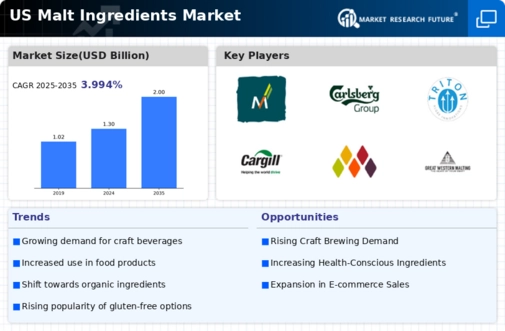Growing Craft Brewing Sector
The craft brewing sector in the US has experienced remarkable growth, which appears to be a significant driver for the malt ingredients market. As of 2025, craft breweries account for approximately 23% of the total beer market share, indicating a shift in consumer preferences towards unique and artisanal products. This trend has led to an increased demand for specialty malts, which are essential for creating distinctive flavors and aromas in craft beers. The malt ingredients market is likely to benefit from this burgeoning sector, as craft brewers often seek high-quality, locally sourced malt to enhance their offerings. Furthermore, the rise of craft brewing has encouraged innovation in malt production, with manufacturers developing new varieties to meet the evolving tastes of consumers. This dynamic interplay between craft brewing and malt ingredients is expected to continue driving market growth in the coming years.
Rising Demand for Organic Products
The increasing consumer preference for organic products is emerging as a pivotal driver for the malt ingredients market. In recent years, organic food sales in the US have surged, with a reported growth rate of 12% in 2024 alone. This trend reflects a broader shift towards health-conscious consumption, where consumers are more inclined to choose products that are free from synthetic additives and pesticides. As a result, malt ingredient producers are adapting their offerings to include organic malts, which are cultivated without the use of chemical fertilizers or pesticides. The malt ingredients market is likely to see a corresponding rise in demand for organic malts, as breweries and food manufacturers seek to align their products with consumer preferences. This shift not only supports sustainable agricultural practices but also enhances the market's appeal to a growing segment of health-conscious consumers.
Increased Focus on Flavor Innovation
The increased focus on flavor innovation within the food and beverage industry is emerging as a key driver for the malt ingredients market. As consumers seek novel and exciting taste experiences, manufacturers are exploring unique flavor profiles that can be achieved through the use of various malt types. The malt ingredients market is likely to see a surge in demand for specialty malts that offer distinct flavors, such as caramel, chocolate, and roasted notes. This trend is particularly evident in the craft brewing sector, where brewers are experimenting with different malt combinations to create innovative beer styles. Additionally, the rise of gourmet food products has prompted food manufacturers to incorporate malt as a flavor enhancer in a variety of applications. As a result, the malt ingredients market is poised to benefit from this growing emphasis on flavor innovation, which is expected to drive product development and market expansion.
Expansion of the Food and Beverage Sector
The expansion of the food and beverage sector in the US is significantly influencing the malt ingredients market. As consumer preferences evolve, there is a growing demand for malt-based products across various food categories, including snacks, baked goods, and non-alcoholic beverages. The malt ingredients market is likely to benefit from this trend, as manufacturers increasingly incorporate malt into their formulations to enhance flavor, texture, and nutritional value. In 2025, the food and beverage sector is projected to grow at a rate of 5% annually, further driving the demand for malt ingredients. This growth is also fueled by the rising popularity of malt-based health foods, which appeal to consumers seeking nutritious alternatives. Consequently, the malt ingredients market is positioned to capitalize on the expanding opportunities within the food and beverage landscape.
Technological Advancements in Malt Production
Technological advancements in malt production are playing a crucial role in shaping the malt ingredients market. Innovations such as automated malting processes and precision agriculture techniques have improved efficiency and quality in malt production. For instance, the implementation of data analytics and IoT technologies allows malt producers to monitor and optimize the malting process, resulting in higher yields and consistent product quality. As of 2025, the malt ingredients market is witnessing a trend towards the adoption of these technologies, which not only enhance production capabilities but also reduce waste and energy consumption. This focus on efficiency is likely to attract investment in the malt sector, further driving market growth. Additionally, advancements in malt processing techniques enable the development of new malt varieties, catering to the diverse needs of brewers and food manufacturers.

















Leave a Comment